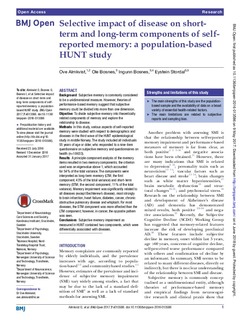| dc.contributor.author | Almkvist, Ove | |
| dc.contributor.author | Bosnes, Ole | |
| dc.contributor.author | Bosnes, Ingunn | |
| dc.contributor.author | Stordal, Eystein | |
| dc.date.accessioned | 2018-06-05T11:40:25Z | |
| dc.date.available | 2018-06-05T11:40:25Z | |
| dc.date.created | 2017-05-11T15:23:16Z | |
| dc.date.issued | 2017 | |
| dc.identifier.issn | 2055-7647 | |
| dc.identifier.uri | http://hdl.handle.net/11250/2500370 | |
| dc.description.abstract | Background: Subjective memory is commonly considered to be a unidimensional measure. However, theories of performance-based memory suggest that subjective memory could be divided into more than one dimension. Objective: To divide subjective memory into theoretically related components of memory and explore the relationship to disease.
Methods: In this study, various aspects of self-reported memory were studied with respect to demographics and diseases in the third wave of the HUNT epidemiological study in middle Norway. The study included all individuals 55 years of age or older, who responded to a nine-item questionnaire on subjective memory and questionnaires on health (n=18 633). Results: A principle component analysis of the memory items resulted in two memory components; the criterion used was an eigenvalue above 1, which accounted for 54% of the total variance. The components were interpreted as long-term memory (LTM; the first component; 43% of the total variance) and short-term memory (STM; the second component; 11% of the total variance). Memory impairment was significantly related to all diseases (except Bechterew’s disease), most strongly to brain infarction, heart failure, diabetes, cancer, chronic obstructive pulmonary disease and whiplash. For most diseases, the STM component was more affected than the LTM component; however, in cancer, the opposite pattern was seen. Conclusions: Subjective memory impairment as measured in HUNT contained two components, which were differentially associated with diseases. | nb_NO |
| dc.language.iso | eng | nb_NO |
| dc.publisher | BMJ Publishing Group | nb_NO |
| dc.rights | Navngivelse-Ikkekommersiell 4.0 Internasjonal | * |
| dc.rights.uri | http://creativecommons.org/licenses/by-nc/4.0/deed.no | * |
| dc.title | Selective impact of disease on short-term and long-term components of self-reported memory: a population-based HUNT study | nb_NO |
| dc.type | Journal article | nb_NO |
| dc.type | Peer reviewed | nb_NO |
| dc.description.version | publishedVersion | nb_NO |
| dc.source.volume | 7 | nb_NO |
| dc.source.journal | BMJ Open sport & exercise medicine | nb_NO |
| dc.source.issue | 5 | nb_NO |
| dc.identifier.doi | 10.1136/bmjopen-2016-013586 | |
| dc.identifier.cristin | 1469696 | |
| dc.description.localcode | © Article author(s) (or their employer(s) unless otherwise stated in the text of the article) 2017. All rights reserved. No commercial use is permitted unless otherwise expressly granted. This is an Open Access article distributed in accordance with the Creative Commons Attribution Non Commercial (CC BY-NC 4.0) license, which permits others to distribute, remix, adapt, build upon this work non-commercially, and license their derivative works on different terms, provided the original work is properly cited and the use is non-commercial. See: http:// creativecommons. org/ licenses/ by- nc/ 4. 0/ | nb_NO |
| cristin.unitcode | 194,67,40,0 | |
| cristin.unitcode | 194,65,35,0 | |
| cristin.unitname | Institutt for psykologi | |
| cristin.unitname | Institutt for psykisk helse | |
| cristin.ispublished | true | |
| cristin.fulltext | original | |
| cristin.qualitycode | 1 | |

